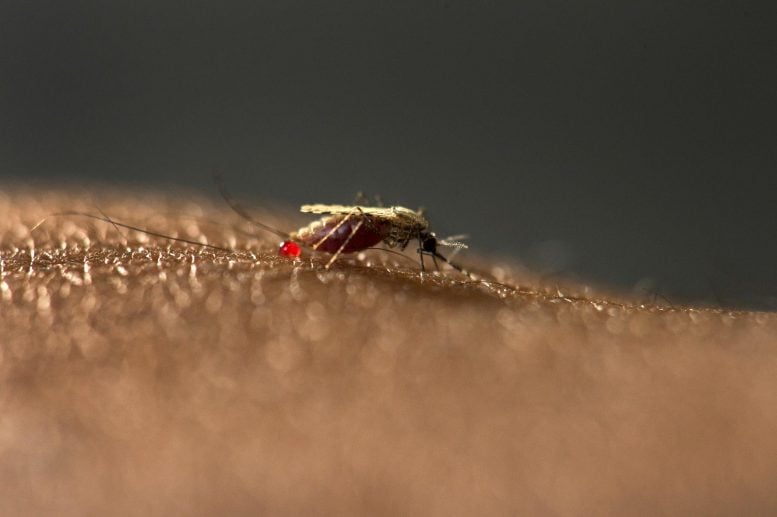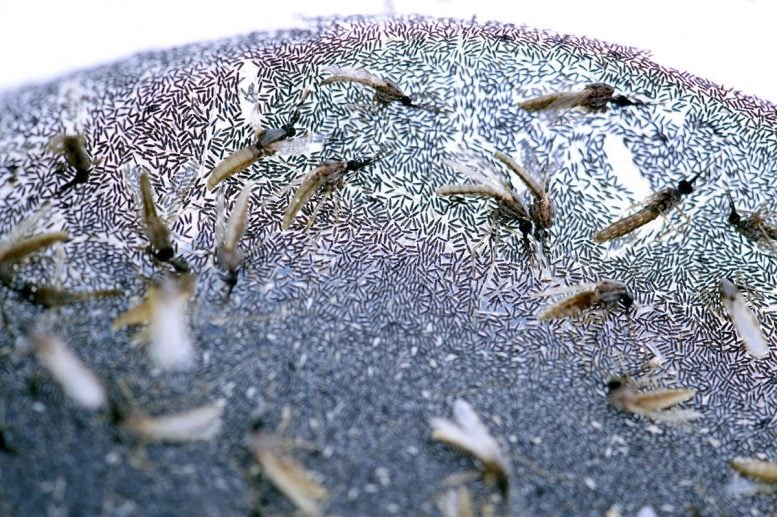Larvae of a new malaria mosquito species are abundantly present in water containers in cities in Ethiopia. The mosquito, Anopheles stephensi, is the main malaria mosquito in India but only appeared on the African continent a few years ago. It has now been found in cities and towns in urban settings in Ethiopia, Sudan, and Djibouti.
Researchers from the Radboud University Medical Center and the Armauer Hansen Research Institute in Ethiopia showed that the invading mosquito species is highly susceptible to local malaria strains. Malaria can therefore become an increasing problem for urban areas in Ethiopia and elsewhere in Africa.
In Africa, malaria is traditionally been a rural disease with towns and cities associated with much lower levels or absence of malaria. This is due to the fact that most African malaria mosquitoes breed in rural areas. However, the introduction of Anopheles stephensi may increase the malaria risk for urban populations.
Over recent years there have been increasing reports of the Asian mosquito species Anopheles stephensi in the Horn of Africa. Anopheles stephensi can reproduce particularly well in man-made containers with clean water. This makes Anopheles stephensi a notorious mosquito species for urban malaria.
The Asian mosquito appears to be particularly susceptible to African malaria
A mosquito species only poses a health risk if it can spread local malaria parasites. “That is why we performed mosquito feeding experiments with the blood of Ethiopian malaria patients. This allowed us to determine whether the local malaria parasite can develop in the new mosquito,” explains Professor of Epidemiology of Tropical Infectious Diseases Teun Bousema of Radboud University Medical Center in Nijmegen. “To our surprise, the Asian mosquito turned out to be even more susceptible to local malaria parasites than our Ethiopian mosquito colony. This mosquito appears to be an extremely efficient spreader of the two main species of malaria.”
With this important puzzle piece, concerns about urban malaria in Africa are increasing. In 2019, the World Health Organization (WHO) already sounded the alarm about the possible consequences of the invasion of Anopheles stephensi in Africa. With these new findings, these concerns seem justified. “An aggressive approach to target this mosquito is now a top priority,” concludes Dr. Fitsam Tadesse. “Only if we act quickly can we prevent the spread to other urban areas on the continent. We must target the mosquito larvae in places where they now occur and prevent mosquitoes from spreading over long distances, for example via airports and seaports. If that fails, the risk of urban malaria will rise in large parts of Africa.”
About malaria
With approximately 216 million cases and 400,000 deaths per year, malaria is one of the most important infectious diseases of our time. Compared to the situation before the year 2000, there is a clear decrease in the number of sick people, especially in Sub-Saharan Africa and South America. Unfortunately, malaria now seems to be on the rise in several areas where it was previously under control.
Plasmodium falciparum and Plasmodium vivax are the main types of malaria for humans. They are transmitted to humans by mosquitoes and vice versa. There are about 60 mosquito species that can transmit human malaria. In Africa, a number of mosquito species are traditionally responsible for the most malaria transmission. Anopheles gambiae mosquitoes have been labeled the most dangerous animal species on earth and are especially common in rural settings in Africa.
Spraying with Insecticides and the use of impregnated mosquito netting against mosquitoes are among the most effective ways to combat malaria. Since 2015, a vaccine has been registered for use. This vaccine, Mosquirix, offers some protection against Plasmodium falciparum malaria, the deadliest form of malaria. Preventing the spread of malaria is considered one of the greatest challenges in the fight against malaria.
Reference: “Anopheles stephensi Mosquitoes as Vectors of Plasmodium vivax and falciparum, Horn of Africa, 2019″ by Fitsum G. Tadesse1Comments to Author , Temesgen Ashine1, Hiwot Teka, Endashaw Esayas, Louisa A. Messenger, Wakweya Chali, Lisette Meerstein-Kessel, Thomas Walker, Sinknesh Wolde Behaksra, Kjerstin Lanke, Roel Heutink, Claire L. Jeffries, Daniel Abebe Mekonnen, Elifaged Hailemeskel, Surafel K. Tebeje, Temesgen Tafesse, Abrham Gashaw, Tizita Tsegaye, Tadele Emiru, Kigozi Simon, Eyuel Asemahegn Bogale, Gedeon Yohannes, Soriya Kedir, Girma Shumie, Senya Asfer Sabir, Peter Mumba, Dereje Dengela, Jan H. Kolaczinski, Anne Wilson, Thomas S. Churcher, Sheleme Chibsa, Matthew Murphy, Meshesha Balkew, Seth Irish, Chris Drakeley, Endalamaw Gadisa and Teun Bousema, 12 January 2021, Emerging Infectious Diseases.
DOI: 10.3201/eid2702.200019











Wow, ugly. If you thought the Covid Lockdown was harsh, imagine a worldwide malaria outbreak and the precautions needed for that. The real enemy of mankind is the mosquito.